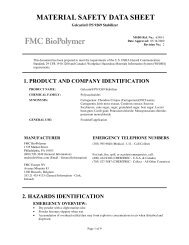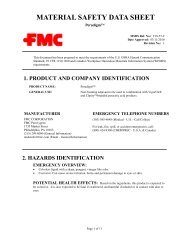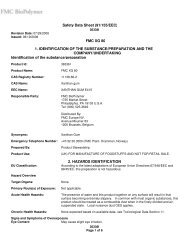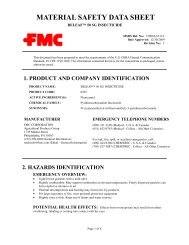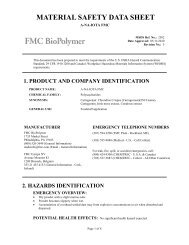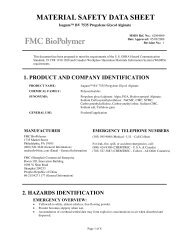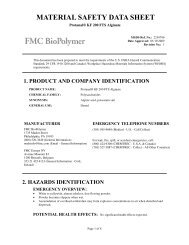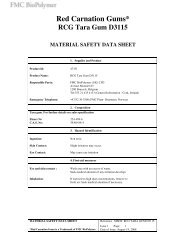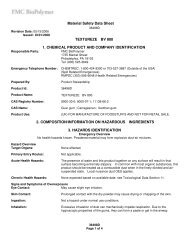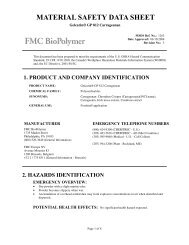material safety data sheet - FMC Corporation
material safety data sheet - FMC Corporation
material safety data sheet - FMC Corporation
Create successful ePaper yourself
Turn your PDF publications into a flip-book with our unique Google optimized e-Paper software.
DUROX® HTP (7722-84-1-10) Date: 03/22/2007<br />
FIRE / EXPLOSION HAZARDS: Product is non-combustible. On decomposition releases<br />
oxygen which may intensify fire.<br />
FIRE FIGHTING PROCEDURES: Any tank or container surrounded by fire should be<br />
flooded with water for cooling. Wear full protective clothing and self-contained breathing apparatus.<br />
FLAMMABLE LIMITS: Non-combustible<br />
SENSITIVITY TO IMPACT: No <strong>data</strong> available<br />
SENSITIVITY TO STATIC DISCHARGE: No <strong>data</strong> available<br />
6. ACCIDENTAL RELEASE MEASURES<br />
RELEASE NOTES: Dilute with a large volume of water and hold in a pond or diked area until<br />
hydrogen peroxide decomposes. Hydrogen peroxide may be decomposed by adding sodium metabisulfite<br />
or sodium sulfite after diluting to about 5%. Dispose according to methods outlined for waste disposal.<br />
Combustible <strong>material</strong>s exposed to hydrogen peroxide should be immediately submerged in or rinsed with<br />
large amounts of water to ensure that all hydrogen peroxide is removed. Residual hydrogen peroxide that is<br />
allowed to dry (upon evaporation hydrogen peroxide can concentrate) on organic <strong>material</strong>s such as paper,<br />
fabrics, cotton, leather, wood or other combustibles can cause the <strong>material</strong> to ignite and result in a fire.<br />
7. HANDLING AND STORAGE<br />
HANDLING: Wear chemical splash-type monogoggles and full-face shield, impervious clothing,<br />
such as rubber, PVC, etc., and rubber or neoprene gloves and shoes. Avoid cotton, wool and leather. Avoid<br />
excessive heat and contamination. Contamination may cause decomposition and generation of oxygen gas<br />
which could result in high pressures and possible container rupture. Hydrogen peroxide should be stored<br />
only in vented containers and transferred only in a prescribed manner (see <strong>FMC</strong> Technical Bulletins).<br />
Never return unused hydrogen peroxide to original container, empty drums should be triple rinsed with<br />
water before discarding. Utensils used for handling hydrogen peroxide should only be made of glass,<br />
stainless steel, aluminum or plastic.<br />
STORAGE: Store drums in cool areas out of direct sunlight and away from combustibles. For bulk<br />
storage refer to <strong>FMC</strong> Technical Bulletins.<br />
COMMENTS: VENTILATION: Provide mechanical general and/or local exhaust ventilation to<br />
prevent release of vapor or mist into the work environment.<br />
Page 3 of 11



